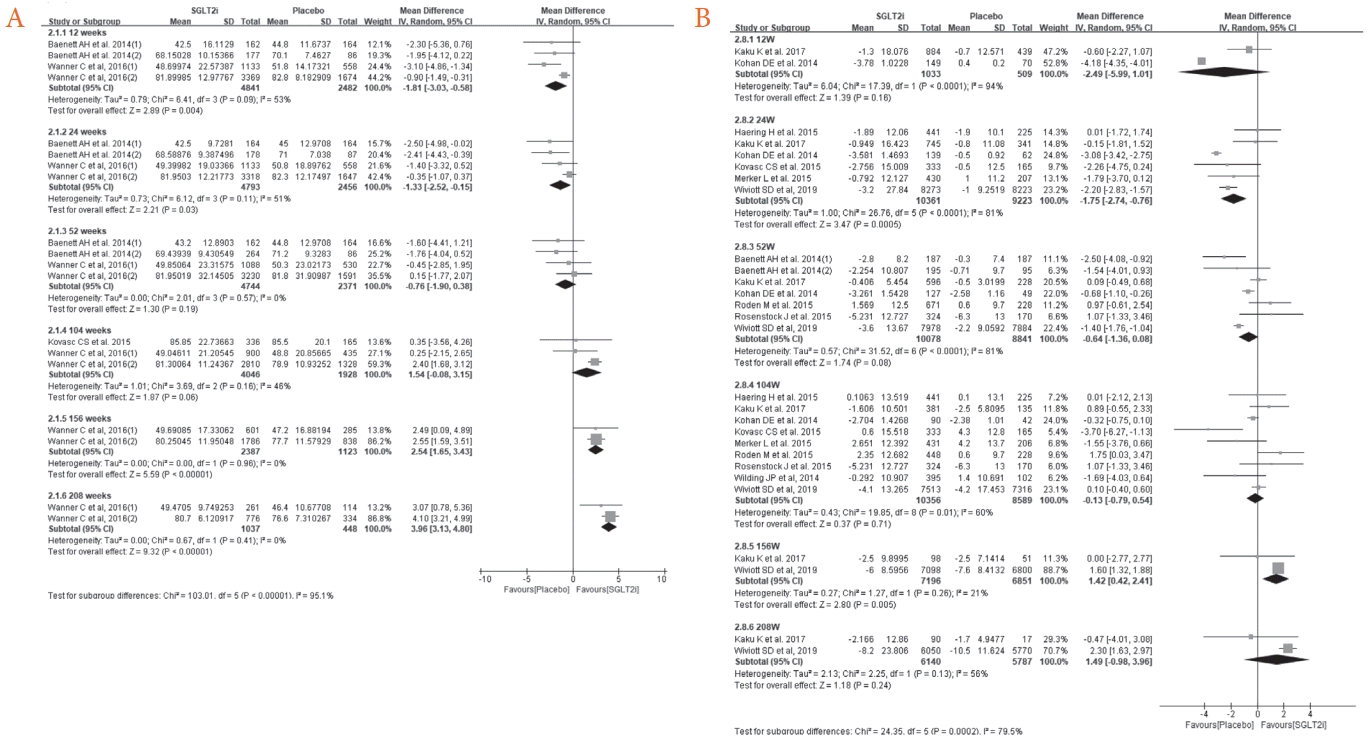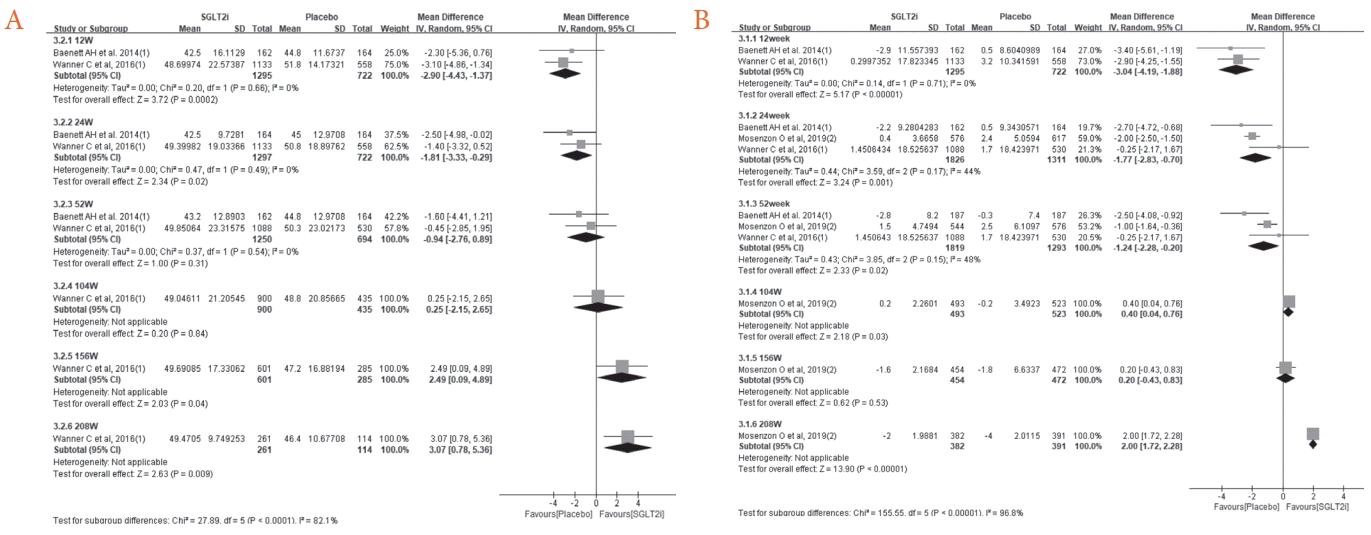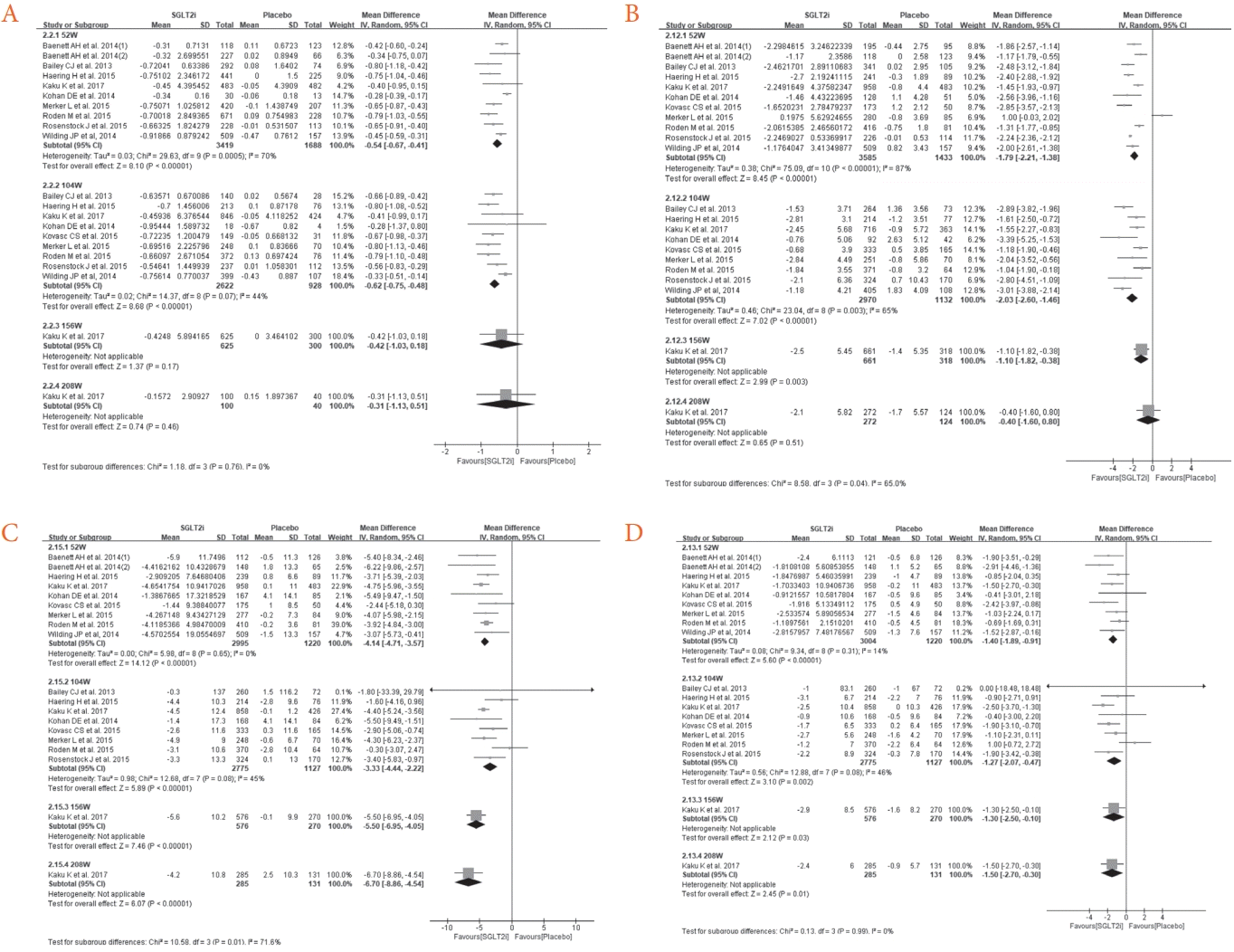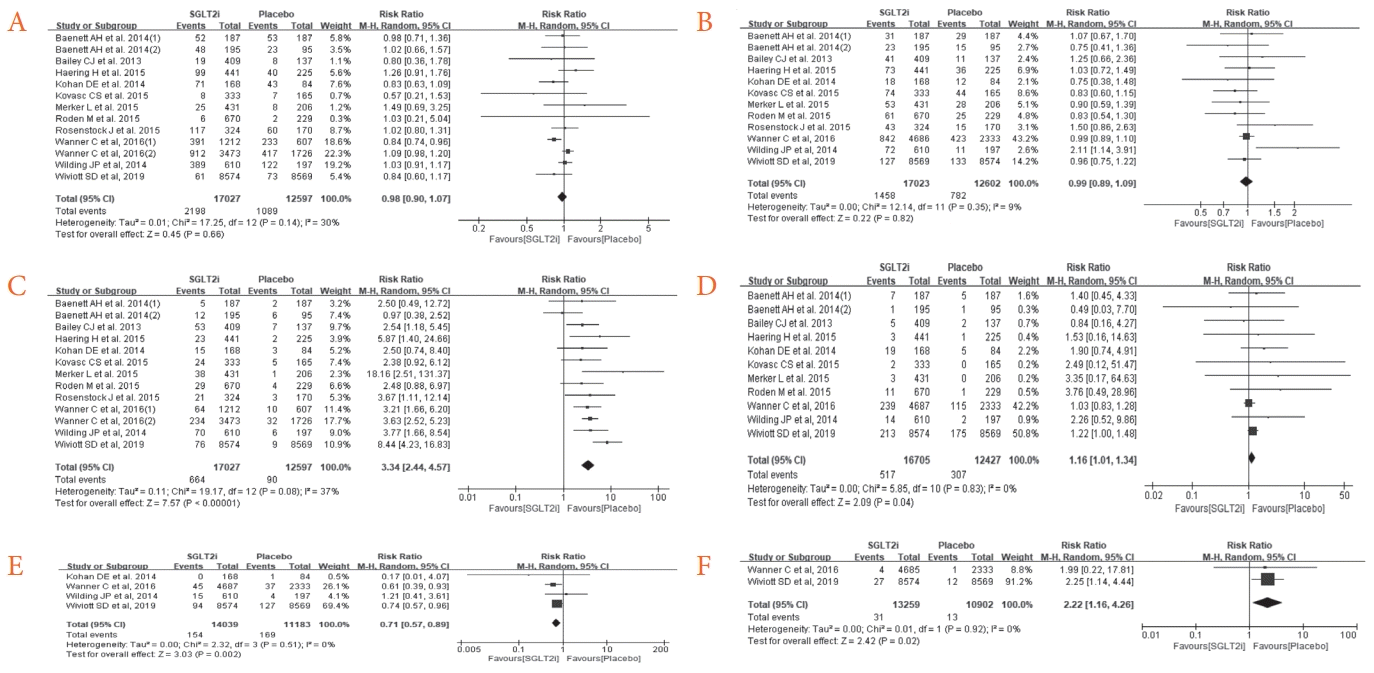Abstract
Chronic kidney disease commonly develops in patients with type 2 diabetes mellitus (T2DM) and is the most common cause of end-stage renal disease and related cardiovascular complications. Meanwhile, despite the current standard of care that includes optimized glucose control and the use of single-agent blockade of the renin-angiotensin-aldosterone system (RAAS), patients with T2DM remain at increased risk for premature death and complications due to cardiorenal causes. Recent studies using sodium-glucose cotransporter 2 (SGLT2) inhibitors have shown not only glucose lowering effects, but also a reduction in blood pressure, weight loss, and lower cardiovascular risk. Regarding renal outcomes, the use of SGLT2 inhibitors slows the progression of kidney disease compared to placebo when added to standard care. However, concern has been raised that currently available SGLT2 inhibitors in Korea may also be associated with improved renal outcomes during long-term treatment. As a result, we aimed to evaluate the effect of long-term SGLT2 inhibitor treatment on renal function in patients with T2DM using meta-analysis.
만성신질환은 당뇨병 또는 고혈압과 같은 만성질환에서 주로 기인하며, 국내에서는 말기신질환으로 신대체요법을 받는 환자 중 당뇨병에 의한 비율이 2010년 이후 급격하게 증가하여 현재 당뇨병이 신대체요법의 가장 흔한 원인질환으로 알려져 있다[1]. 또한, 만성신질환은 말기신부전으로의 진행, 심혈관질환 발생 및 높은 사망률과도 연관되어 있다. 현재까지 만성신질환의 적절한 치료 및 관리로, 알부민뇨의 치료(안지오텐신수용체차단제 또는 안지오텐신전환효소억제제), 심혈관 위험인자의 조절(이상지질혈증, 혈당 및 혈압 관리)과 함께 잠재적으로 신독성을 유발할 수 있는 약제에 대한 주의와 용량 조절 등이 제시되고 있다[2].
최근 sodium-glucose cotransporter 2 (SGLT2) 억제제에 관한 대규모 심혈관 안정성 연구에서, SGLT2 억제제 투여가 혈당을 낮출 뿐만 아니라 심혈관질환 사건 및 사망률을 낮춘다는 결과가 보고되었다[3-5]. 이 중에서 canagliflozin과 empagliflozin을 이용한 무작위 비교대조연구에서 이차결과지표로 신기능 보호 효과를 보여주었는데, 각각의 신기능 복합 결과의 구성에 있어서는 차이가 있었다. Empagliflozin을 이용한 연구는 신기능 악화의 발생 또는 진행을 현성알부민뇨(소변 알부민-크레아티닌 비율 > 300 mg/g), 혈청 크레아티닌 수치의 2배 상승과 함께 사구체여과율(estimated glomerular filtration rate, eGFR)의 감소(< 45 mL/min/1.73 m2), 신대체요법의 시작 또는 신질환으로 인한 사망을 결과지표로 정의하였고[6], canagliflozin을 이용한 연구에서는 사구체여과율의 40% 감소, 신대체요법의 시행 또는 신질환으로 인한 사망으로 결과지표를 정의하였다[5]. Dapagliflozin을 이용한 심혈관 안정성 연구에서는 신기능에 대한 결과는 보고하지 않았다[4]. 한편 각 연구에 포함된 환자군의 임상 양상 및 신기능 상태가 다르고 각 연구 별로 추적 관찰 기간이 달라서 SGLT2 억제제가 신기능 자체에 어떠한 영향을 미치는지에 대해서는 아직 결론을 내릴 수 없다. 따라서 우리는 현재 국내에서 제2형 당뇨병 환자에게 처방이 가능한 SGLT2 억제제 중 위약 대비 52주 이상 추적 관찰한 무작위 대조군 연구(review, case series, single arm study 제외)들에서 장기간 SGLT2 억제제 치료가 신장기능에 미치는 효과를 메타 분석을 통해 알아보고자 하였다. 또한 제2형 당뇨병 환자에서 장기간 SGLT2 억제제 사용에 따른 이득과 위해의 균형을 고려하여 권고안에 반영하고자 하였다.
“제2형 당뇨병에서 장기간의 SGLT2 억제제 치료는 신장기능 개선에 도움이 되는가?”를 핵심 질문으로 하여 메타분석을 위해 전문 사서에 의해 체계적인 문헌 검색을 시행하였다. 데이터베이스는 PubMed, EMBASE, Cochrane library를 이용하였고, 2015년 1월 1일부터 2020년 3월 31일까지 영문으로 발표된 문헌 중, 국내에서 처방 가능한 SGLT2 억제제(dapagliflozin, empagliflozin, ipragliflozin, ertugliflozin)를 사용한 무작위 대조임상연구 중 약제 치료기간이 52주 이상인 연구만을 포함하였다. 문헌고찰 결과, 검색조건에 따라 위약과 비교된 무작위 대조임상연구의 결과가 있는 dapagliflozin, empagliflozin만 포함하였고, 문헌 검색과 평가를 위한 population, intervention, comparator, outcomes (PICO)는 Table 1과 같다.
이득에 관한 11개의 무작위 대조임상연구 중 12개 논문[4,6-16]을 분석하고 독립된 2인이 평가하였다. 각각의 연구들은 비뚤림에 대해서는 중간 혹은 높은 질로 잘 계획되었다고 평가하였으나(Supplementary Fig. 1), 핵심 질문의 근거수준(level of evidence) 평가에서는 아래 두 가지 이유로 하향조정하였다.
신장기능의 일차결과지표(primary outcome)로 사구체 여과율(mL/min/1.73 m2)을 선정하였고, 최대 208주까지 보고된 결과들을 대상으로 메타분석을 실시하였다. 12주와 24주에서는 중재군의 사구체여과율이 대조군에 비해 낮았고(12주: -1.81, 95% confidence interval [CI] -3.03 to -0.58; 24주: -1.33, 95% CI -2.52 to -0.15), 52주와 104주에서는 대조군과 차이가 없었고(52주: -0.76, 95% CI -1.90 to 0.38; 104주: 1.54, 95% CI -0.08 to 3.15), 156주와 208주에서는 대조군보다 유의하게 높았다(156주: 2.54, 95% CI 1.65 to 3.43; 208주: 3.96, 95% CI 3.13 to 4.80) (Fig. 1A). 사구체여과율의 변화(mean change of eGFR, mL/min/1.73 m2)는 156주에서 중재군이 대조군보다 유의하게 높았다(156주: 1.42, 95% CI 0.42 to 2.41) (Fig. 1B).
분석 대상자 중 만성신질환 3기(사구체여과율 30~59 mL/min/1.73 m2) 대상자만을 따로 분석하였을 때, 12주와 24주에서는 중재군의 사구체여과율이 대조군에 비해 낮았고(12주: -2.90, 95% CI -4.43 to -1.37; 24주: -1.81, 95% CI -3.33 to -0.29) 156주와 208주에서는 중재군의 사구체여과율이 대조군에 비해 높은 경향을 보였다(156주: 2.49, 95% CI 0.09 to 4.89; 208주: 3.07, 95% CI 0.78 to 5.36) (Fig. 2A). 사구체여과율의 변화 208주째 대조군보다 중재군에서 유의미한 효과추정치를 보였다(208주: 2.00, 95% CI 1.72 to 2.28) (Fig. 2B).
전체 대상자에서 당화혈색소, 체중, 혈압 변화를 비교하였을 때, 104주째 중재군에서 당화혈색소 변화는 -0.62% (95% CI -0.75 to -0.48), 체중 변화는 -2.03 (95% CI -2.60 to -1.46) , 수축기 혈압 변화는 -3.33 mm Hg (95% CI -4.44 to -2.22), 이완기 혈압 변화는 –1.27 mm Hg (95% CI -2.07 to -0.47)로 혈당, 체중, 혈압은 대조군 대비 중재군에서 유의미한 감소를 보였다(Fig. 3). 이상에서 제2형 당뇨병 환자에서 장기간 SGLT2 억제제 치료는 사구체여과율 감소를 억제하는 효과가 있을 것으로 기대된다.
대조군보다 중재군에서 초반기 사구체여과율 감소가 있었으며(Fig. 1) 특히 만성신질환 3기 환자에서는 SGLT2 억제제 사용 초기에 사구체여과율 감소가 더 크게 나타났다(Fig. 3). 하지만 2년 이상 추적 관찰 기간 동안 탈락된 환자가 많아 초반에 사구체여과율 감소를 보였던 대상자들에서 이후 사구체여과율이 회복되었는지 여부에 대해서는 알 수 없었기 때문에 SGLT2 억제제 사용시 초기에 신장기능을 모니터링하고 이후에도 정기적이고 지속적인 모니터링이 필요하다.
208주 관찰 기간 동안 중재군에서 저혈당 발생(risk ratio [RR] 0.98, 95% CI 0.90 to 1.07), 요로감염(RR 0.99, 95% CI 0.89 to 1.09)의 위험은 증가하지 않았으나, 생식기계 감염(RR 3.34, 95% CI 2.44 to 4.57)과 수분 부족(RR 1.16, 95% CI 1.01 to 1.34)은 의미있게 증가하였다. 반면 급성신부전(RR 0.71, 95% CI 0.57 to 0.89), 당뇨병성케톤산증(RR 2.22, 95% CI 1.16 to 4.26)의 발생은 통계적으로 유의미하였으나 발생건수가 너무 적어 임상적 유의성은 없는 것으로 보인다(Fig. 4).
제2형 당뇨병 환자에서 2년 혹은 그 이상 장기간 SGLT2 억제제 치료는 위약 대비 사구체여과율 감소를 억제하는 효과가 있었다(Fig. 1, 2). 또한 당화혈색소 감소와 함께 체중, 수축기 및 이완기 혈압 감소로 인한 추가 이득이 관찰되었다(Fig. 3). SGLT2 억제제 치료 시 발생할 수 있는 위해로는 생식기계 감염, 탈수 등이 있었으나 생식기계 감염이나 탈수는 비교적 간단한 예방적 조치와 치료로 쉽게 개선되므로 심각한 위해는 아닌 것으로 판단된다(Fig. 4). 따라서 이를 종합해 볼 때 이득이 위해를 앞선다고 볼 수 있다.
그러나 2년 이상 사구체여과율을 장기 추적 관찰한 연구가 적고 그나마 장기간 연구들에서는 탈락률이 높았다. 한편 만성신질환 3기에서도 의미 있는 효과추정치를 보였으나 이 분석에 포함된 연구가 단 1개뿐이어서(Fig. 2) 중등도의 신기능 저하를 동반한 환자에서 SGLT2 억제제의 신장기능에 대한 효과는 추가적인 연구를 통해 확인이 필요하다. 대조군에 비해 중재군에서 SGLT2 억제제 치료 초반에 사구체여과율이 감소하였는데(Fig. 1), 만성신질환 3기 대상자들은 그 감소가 더 컸었다(Fig. 2). 따라서 SGLT2 억제제 치료 시 초반기 사구체여과율 감소에 대한 위해가 존재하므로 SGLT2 억제제를 투여할 때 신장기능에 대한 정기적이고 지속적인 모니터링이 매우 중요하다.
한편, 아시아인이 다수 포함된 연구결과는 전체 대상자의 연구결과와 달랐었다. 전체 대상자 연구에서는 초반기 사구체여과율이 감소하다가 시간이 지나면서 회복되어 2년 초과 시 개선되는 경향을 보인 반면에, 아시아인이 다수 포함된 연구에서는 대조군과 중재군 간 초반기 사구체여과율 감소의 차이가 없었고, 208주까지 장기간 추적 관찰 기간 동안에도 유의미한 차이가 없었다(사구체여과율 변화, -0.47 mL/min/1.73 m2 [95% CI -4.01 to 3.08]) (Supplementary Fig. 2). 따라서 아시아인에서도 장기간의 SGLT2 억제제 치료가 사구체여과율 감소를 억제하는 효과가 있을지에 대해서는 아직 불분명하다. 그러므로 향후 아시아인, 특히 한국인을 대상으로 한 추가적인 연구결과가 필요하다.
이득과 위해를 종합하였을 때, SGLT2 억제제는 위약에 비해 사구체여과율 감소를 억제하는 이득이 있을 수 있으나 그 이득이 되는 대상군이 명확하지 않고, 심각한 위해는 없으나 초반기 사구체여과율 저하가 있을 수 있으므로 약제 사용 시 신장기능에 대한 모니터링과 주의가 필요하다. 또한 이러한 이득과 위해의 균형에 있어서 불확실성이 존재하므로 사구체여과율 감소 억제를 목적으로 모든 제2형 당뇨병 환자에게 SGLT2 억제제 사용을 권고할 수는 없다. 따라서 권고 강도는 “weak recommendation”으로 결정하였다. 이에 최종 권고안은 아래와 같이 결정하였다.
제2형 당뇨병 환자에서 장기간의 SGLT2 억제제 치료는 일부 대상자에서 사구체여과율 감소를 억제하는 효과가 있으므로, 사구체여과율을 지속적으로 추적 관찰하면서 SGLT2 억제제를 사용할 것을 권고한다(weak recommendation, low evidence).
제2형 당뇨병 환자에게 메트포르민 이후 추가 병합요법으로 선택할 수 있는 혈당강하제들은 SGLT2 억제제 외에도 다른 경구혈당강하제와 주사제가 있으나, 현재로서는 장기간 신장기능 개선 효과를 입증한 근거가 부족하다. 또한 SGLT2 억제제의 사구체여과율 변화를 보기 위해서는 최소한 1년 이상의 장기적인 치료와 함께, 동반 위험인자의 교정(고혈압, 이상지질혈증, 비만 등), 기타 신장기능 개선이 증명된 약제(안지오텐신전환억제제, 안지오텐신수용체차단제 등)의 우선적인 사용 등을 충분히 고려하여 SGLT2 억제제 사용 여부를 결정해야 한다. SGLT2 억제제 투여 후 환자의 주관적 불편감(급격한 체중 감소나 빈뇨 등), 요로감염, 비용, 초기 신장기능 감소에 대한 주의가 필요하며, 감염이나 탈수에 대한 문제는 환자에게 미리 발생 가능성을 충분히 고지하고 조기 발견 및 적절한 조치로 해결할 수 있도록 해야 한다. 또한 기존의 대부분 장기 대규모 연구결과들은 아시아인의 비율이 적은 서양인 위주의 결과이므로 향후 한국인 대상의 추가 연구가 필요하다.
Supplementary Materials
Supplementary Table 1.
Study quality and risk of bias assessment. The risk of bias for each randomized controlled trial was classified as adequate (low risk of bias, green color), unclear (unclear risk of bias, yellow color), or inadequate (high risk of bias, red color) using the Cochrane Risk of Bias Tool.
Supplementary Table 1.
Results of Asian dominant studies. Effect of sodium-glucose cotransporter 2 inhibitors (SGLT2i) on change of estimated glomerular filtration rate.
SD, standard deviation; IV, inverse variance; CI, confidence interval.
ACKNOWLEDGMENTS
This work was performed through the cooperation of the Korean Diabetes Association and the Korean Society of Nephrology.
REFERENCES
1. Jin DC. Major changes and improvements of dialysis therapy in Korea: review of end-stage renal disease registry. Korean J Intern Med. 2015; 30:17–22.

2. Chen TK, Knicely DH, Grams ME. Chronic kidney disease diagnosis and management: a review. JAMA. 2019; 322:1294–304.
3. Zinman B, Wanner C, Lachin JM, Fitchett D, Bluhmki E, Hantel S, et al. Empagliflozin, cardiovascular outcomes, and mortality in type 2 diabetes. N Engl J Med. 2015; 373:2117–28.

4. Wiviott SD, Raz I, Bonaca MP, Mosenzon O, Kato ET, Cahn A, et al. Dapagliflozin and cardiovascular outcomes in type 2 diabetes. N Engl J Med. 2019; 380:347–57.

5. Neal B, Perkovic V, Mahaffey KW, de Zeeuw D, Fulcher G, Erondu N, et al. Canagliflozin and cardiovascular and renal events in type 2 diabetes. N Engl J Med. 2017; 377:644–57.

6. Wanner C, Inzucchi SE, Lachin JM, Fitchett D, von Eynatten M, Mattheus M, et al. Empagliflozin and progression of kidney disease in type 2 diabetes. N Engl J Med. 2016; 375:323–34.

7. Barnett AH, Mithal A, Manassie J, Jones R, Rattunde H, Woerle HJ, et al. Efficacy and safety of empagliflozin added to existing antidiabetes treatment in patients with type 2 diabetes and chronic kidney disease: a randomised, double-blind, placebo-controlled trial. Lancet Diabetes Endocrinol. 2014; 2:369–84.

8. Kovacs CS, Seshiah V, Merker L, Christiansen AV, Roux F, Salsali A, et al. Empagliflozin as add-on therapy to pioglitazone with or without metformin in patients with type 2 diabetes mellitus. Clin Ther. 2015; 37:1773–88.e1.

9. Merker L, Häring HU, Christiansen AV, Roux F, Salsali A, Kim G, et al. Empagliflozin as add-on to metformin in people with type 2 diabetes. Diabet Med. 2015; 32:1555–67.

10. Roden M, Merker L, Christiansen AV, Roux F, Salsali A, Kim G, et al. Safety, tolerability and effects on cardiometabolic risk factors of empagliflozin monotherapy in drug-naïve patients with type 2 diabetes: a doubleblind extension of a phase III randomized controlled trial. Cardiovasc Diabetol. 2015; 14:154.

11. Rosenstock J, Jelaska A, Zeller C, Kim G, Broedl UC, Woerle HJ. Impact of empagliflozin added on to basal insulin in type 2 diabetes inadequately controlled on basal insulin: a 78-week randomized, double-blind, placebocontrolled trial. Diabetes Obes Metab. 2015; 17:936–48.

12. Wilding JP, Woo V, Rohwedder K, Sugg J, Parikh S; Dapagliflozin 006 Study Group. Dapagliflozin in patients with type 2 diabetes receiving high doses of insulin: efficacy and safety over 2 years. Diabetes Obes Metab. 2014; 16:124–36.

13. Bailey CJ, Gross JL, Hennicken D, Iqbal N, Mansfield TA, List JF. Dapagliflozin add-on to metformin in type 2 diabetes inadequately controlled with metformin: a randomized, double-blind, placebo-controlled 102-week trial. BMC Med. 2013; 11:43.

14. Kaku K, Lee J, Mattheus M, Kaspers S, George J, Woerle HJ. Empagliflozin and cardiovascular outcomes in Asian patients with type 2 diabetes and established cardiovascular disease- results from EMPA-REG OUTCOMEⓇ. Circ J. 2017; 81:227–34.
Fig. 1.
Effect of sodium-glucose cotransporter 2 inhibitors (SGLT2i) on (A) estimated glomerular filtration rate (eGFR), and (B) change in eGFR from baseline.
SD, standard deviation; IV, inverse variance; CI, confidence interval.

Fig. 2.
Results for patients with estimated glomerular filtration rate (eGFR) below 60 mL/min/1.73 m2. Effect of sodium-glucose cotransporter 2 inhibitors (SGLT2i) on (A) eGFR, and (B) change of eGFR from baseline.
SD, standard deviation; IV, inverse variance; CI, confidence interval.

Fig. 3.
Effect of sodium-glucose cotransporter 2 inhibitors (SGLT2i) on change in (A) HbA1c, (B) body weight, (C) systolic blood pressure, and (D) diastolic blood pressure.
SD, standard deviation; IV, inverse variance; CI, confidence interval.

Fig. 4.
Effect of sodium-glucose cotransporter 2 inhibitors (SGLT2i) on (A) hypoglycemia, (B) urinary tract infection, (C) genital infection, (D) volume depletion, (E) acute kidney injury, and (F) diabetic ketoacidosis.
M-H, Mantel-Haenszel; CI, confidence interval.

Table 1.
The framework of PICO in developing the focused question




 PDF
PDF Citation
Citation Print
Print


 XML Download
XML Download